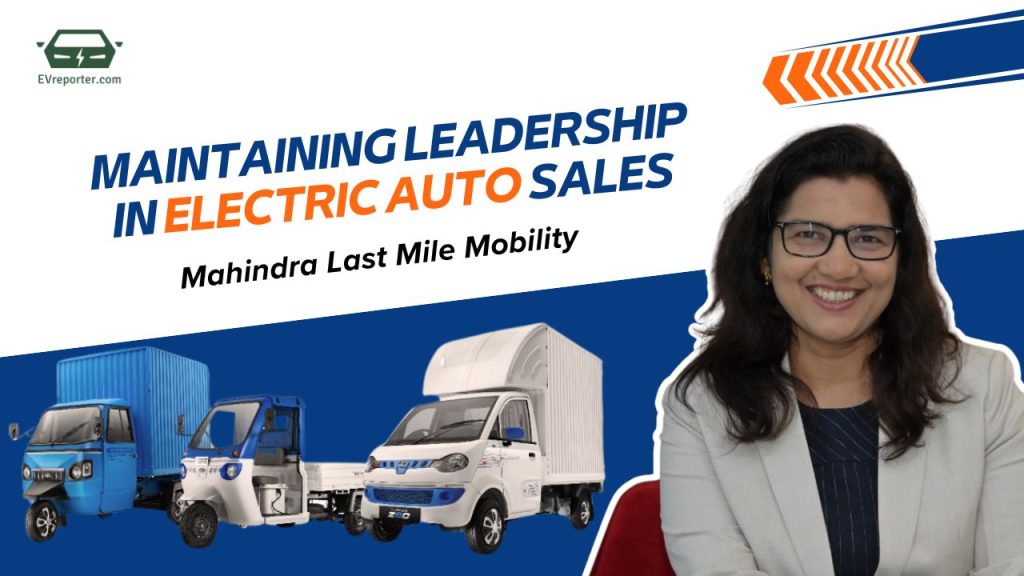Mahindra Last Mile Mobility – Focused on Maintaining Leadership and Momentum
Suman Mishra, MD & CEO – Mahindra Last Mile Mobility shares her take on the increasing penetration of EVs in the L5 3W segment, intensifying competition in the electric commercial vehicle space, evolving customer profiles and outlook towards the emerging secondary EV market.
Today, all 3W manufacturers — including new entrants and legacy players — are offering electric models. Mahindra Last Mile Mobility continues to lead the market in both the L5 passenger and cargo segments. Could you share what strategies have helped you maintain this leadership even as competition intensifies?
Electrification in the L5 category today is around 32% year-to-date, which is a great number for the segment — but that still means about 68% is left to be electrified. In my view, the entry of more players, especially strong OEMs, helps the category. They bring credibility, offer more product choices, and, in turn, accelerate electrification.
About three or four years ago, we had around 60–70% market share, but the market wasn’t really growing. Today, being number one truly means more. The presence of multiple OEMs shows that this has become a bona fide category.
Coming to strategy – this category sells based on the overall offering. Customers want products that meet their needs at an affordable price. They also want peace of mind with service or maintenance. Financing plays an even bigger role than pricing. Even for the down payment, customers need access to multiple financiers. Then comes service — both reach and quality. Much of our technology is localised and developed in-house, enabling us to resolve service issues quickly.
These three factors — product, financing, and service — are what define leadership. Wherever we can deliver across these parameters, we lead in those micro-markets. And where others do better, they lead there. We aim to keep innovating and bringing better products to customers. We aim to keep moving forward on all fronts.
What kind of aftermarket support does MLMM provide for its electric CV customers, particularly in Tier 2 and Tier 3 markets?
Today, we have around 800 touchpoints, covering both sales and service.
Our reach in Tier 2 and Tier 3 markets is particularly strong. Historically, when Mahindra sold Alfa diesel vehicles, these weren’t allowed in cities, sales were mostly outside urban areas. That gave us an existing channel, which we’ve now strengthened significantly to build a robust network across all three-wheeler markets.
We’re also trying out several innovative schemes. For example, we offer roadside assistance and have local technicians called Mahindra Mitra Technicians. These aren’t full 3S outlets, but they are Mahindra-trained and run smaller setups where they can sell spares and quickly service vehicles. Additionally, we have mobile service initiatives, such as Mahindra Mobile Seva (MMS) vans and Mahindra Service on Wheels (MSoW) on a 2W, which allow us to reach customers directly. For fleet customers, we often provide dedicated technicians on-site.
For the different vehicle segments — L5 three-wheelers as well as SCVs — who are your current priority customers? Are you focusing more on individual delivery and cargo operators (DCOs), or is the demand mainly coming from fleet operators?
In the L5N or cargo segments, we saw a significant rise in demand last year from e-commerce delivery fleet partners. However, that momentum seems to have slowed down recently. The industry has naturally consolidated, with only a few major players remaining active in the e-commerce delivery space. Now the growth is coming from smaller, captive fleets — businesses that own a few vehicles for their own use.
Government fleets, such as those used for waste collection and other municipal operations, are also becoming an important part of the cargo segment. Of course, traditional users such as FMCG companies and distributors remain key customers, and fleet service providers also play a role.
But overall, the major growth right now is happening in the captive fleet segment. Captive essentially means vehicles used for one’s own business needs, not for third-party transport or fleet services. Earlier, large fleets — especially in e-commerce — dominated usage, and while several good delivery companies still exist, the focus has now shifted more toward individual or self-use customers.
While you’re constantly expanding your reach, how do you ensure that the quality of service and customer support keep pace with this expansion?
Our focus is on two things: ensuring high-quality service and having the right reach. Wherever a customer goes, they should be able to access spare parts quickly. We’ve also launched an accidental insurance scheme called Uday NXT, offering a ₹20 lakh cover that provides customers with added protection beyond transactional aspects.
Being a new category, we’re constantly innovating to find the sweet spot: how to deliver quality service, where to deliver it, and at what cost. Across these three metrics, we’re always experimenting to find the best solution.
You offer both three- and four-wheeler commercial vehicles. Over the next two to three years, which segment do you expect to drive growth more significantly?
All segments have potential. Right now, electrification in four-wheelers is at a very early stage. The SCV segment has seen a bit of a slowdown; in fact, the overall four-wheeler ICE category contracted last year. But I believe it’s a cyclical industry, and the trend should reverse — once that happens, the category will grow again. In the L5 category, I expect electrification to continue increasing — both in passenger and cargo segments.
So, there are positive tailwinds in multiple areas. Overall, across both L5 and 4W SCVs, I’m optimistic about seeing steady growth.
Beyond the vehicle itself, what other solutions or value-added offerings are you providing for fleet operators?
Quite a few, actually.
- We’ve been offering a battery-as-a-service model for over three years now through one of our financing partners. In this model, if a customer prefers to buy only the vehicle and not the battery, the battery is owned by the financier, and the customer pays for the vehicle.
- We also offer value-added products and customization for specialized applications on our vehicles. For instance, we help fabricate mobile coffee shops, drone-controlled pesticide spraying application and so on. These tailored solutions add value for customers who need vehicles for their business needs.
As for battery swapping, to be candid, we haven’t focused on that. It has relevance in some niche applications, but we don’t currently see it as a major growth driver.
On the other hand, we’re actively working on charging infrastructure.
For fleet operators, we collaborate with our charging partners to install chargers at their fleet hubs. In markets with a high concentration of our vehicles, we also work with charging operators to set up chargers in common or high-traffic areas. Enabling convenient charging solutions is definitely a key focus area for us.
What are your thoughts on the emerging ultra-fast charging technologies that some startups are developing for smaller vehicles, including 3Ws? Is Mahindra also planning to explore or invest in rapid charging solutions for its electric vehicle range?
We are in discussions with several such companies to explore potential fitments. However, as I discussed earlier, this is a commercial vehicle category — so adoption will only make sense if it’s economically viable for the customer and if the technology is widely available. For a commercial vehicle user, reliability is key. If they’re not sure they can get a charger along their route, it’s very difficult for them to switch. Fast charging is certainly an exciting technology, but its cost is currently higher, which can impact the overall economics for the customer.
How do you view the emerging EV resale market? Are there any initiatives from Mahindra to facilitate the secondary market?
Resale is very important for any commercial vehicle because it enables a second round of electrification — the same customer can sell their old vehicle and buy a new one. In EVs, the main factor affecting resale value is the battery — its remaining capacity and the value it holds. The rest of the vehicle, like the motor and other components, are well-understood and established technologies, so that part is relatively straightforward.
For batteries, we’ve conducted several pilots to estimate their value. While we haven’t seen a huge influx yet, we aim to establish a clear exchange value when vehicles are returned. Batteries can also be repurposed for secondary applications or, at the end of life, recycled to extract value. We anticipate that cargo vehicles may return faster because they’re used more intensively, whereas passenger vehicles, often owned by individual drivers, may last longer. Overall, we’re well-prepared. We’ve conducted multiple pilots to understand how the resale market will evolve. In areas with high vehicle density, a resale ecosystem is already starting to emerge, and the market can innovate in ways that often surprise you.
A few startups are also working to facilitate the resale of vehicles, which I’ve seen firsthand. We’re already collaborating with a few of them on different initiatives. When you see this influx of interest, it’s clear that the challenges in this space will be addressed.
Some startups are trying to build frameworks to determine and standardize the value of a vehicle in the secondary market.
Yes, exactly. These startups want access to battery charge data so they can help establish a vehicle’s resale value. That’s precisely what we’re also working on. By the time the first batch of batteries returns — likely by mid to late next year — we’ll be ready. In the meantime, we’re addressing the challenge through more focused pilot programs.
Mahindra has now surpassed 2.8 lakh electric commercial vehicle sales, What are your specific sales and market share targets going forward?
By the end of this year, we expect to definitely surpass 3 lakh. Currently, according to Vahan, we hold around 37% of the L5 market. We hope to retain or slightly grow this share, but we don’t have formal targets. As the overall market and electrification grow, it’s a win-win for everyone. Our primary focus remains on maintaining our leadership and not losing momentum.
Disclaimer: This interview was taken in October 2025 and was first published in EVreporter Nov 2025 magazine.
Also Read: Mahindra Last Mile Mobility hits 2,00,000 EV sales in India’s commercial segment
Subscribe today for free and stay on top of latest developments in EV domain.





